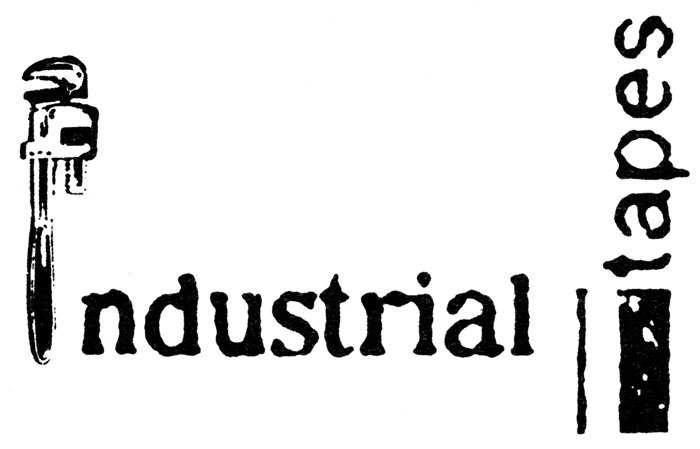The first era of punk in New Zealand in the late 1970s and early 1980s produced surprisingly few fanzines. Empty Heads, a printed, folded A4 magazine, edited by photolithographic apprentice and punk enthusiast Paul Luker in Auckland, with help from his mate Phil Yates, was the first. Two issues were produced, in late 1980 and early 1981, and it was available mostly in Auckland.
Luker had joined his brother in Auckland inner city suburb Parnell in early 1979 after a brief period in Wellington in 1978 studying journalism.
“In the early days I had bugger all money and spent most of my time wandering the town,” recalls Luker. “I couldn’t really help but notice what was happening musically. The Windsor Castle was just around the corner. There was The Globe and Occidental on the way home from work and Knox Hall up the road, Rip It Up, Radio B and Barry Jenkin on 1ZM at night.
“Auckland was the magnet for the punk movement at this point. It was everywhere when I got here.”
“Auckland was the magnet for the punk movement at this point. It was everywhere when I got here. They were the most active. They had the most interesting posters. When I got to know those people I realised how independent and determined to get it done they were. You didn’t pay any attention to TV or radio. You just went ahead and did it."
There was a dance at Knox Hall, Parnell with The Dentists and The Sloth Creatures. “It was drunken and riotous and the cops came. The Sloth Creatures played ‘12XU’ for ages. I’d never encountered live music that filled the room so much. It was outrageously loud with a measured aggression that was still kind of secure because you were on the inside and I figured it was right that music should be this exciting.
A few months later Luker saw Proud Scum at the Occidental. “I stood at the door for ages until someone dragged me inside. For a while, I felt as if I was part of the show.”
Luker’s fellow apprentices at Auckland Technical Institute (now AUT) were buzzing with the new music. “Somebody’s brother was in The Spelling Mistakes and another in The Features. Badges, posters and opinion were everywhere. I read the NME inside out and began buying records by mail order from Cob Records in Porthmadog [in Wales]. I couldn’t wait for them to get here. New Zealand still had at least one pressing plant left then, but I don’t think they were pressing Swell Maps and Blurt. Imports were priced over the top and even if they were pressed in Australia it added months to a release date. I really liked the overseas covers, the notable distinctions of ink, colour, stock etc.”
Music aside, Luker first appeared on stage as a performing poet. “I’d been writing poetry before I came to Auckland. I’d been to The Globe and saw readings and it wasn’t as [pretentious] as I thought. It wasn’t as bearded, there were some young people there. The Globe had bands and being at tech on a first year block course, it was close. After reading at The Globe I met John Pule and thought we could busk like the bands that played in Vulcan Lane. The Features also played at the end of Queen Street. I got this old Gestetner stencil printing machine and thought, ‘let’s print some’. They were really small pamphlets at first, sheets. We thought let’s go and read and sell this stuff. So we got an arts grant and toured in 1981 and sold these books. John continued with poetry and I didn’t because it seemed then that music was a whole lot more fun, although I did read at a few gigs.”
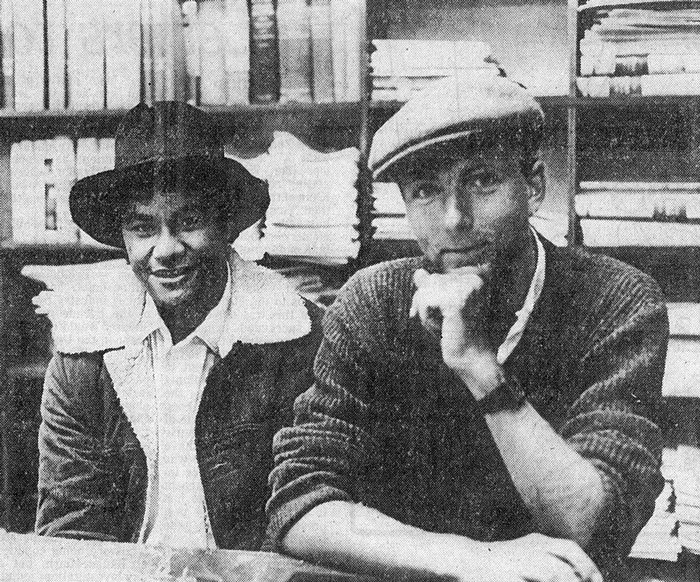
John Pule and Paul Luker in 1981
It was a short step to fanzine Empty Heads. “I wanted to get in closer [to the music scene]. I just couldn’t get enough of it. It seemed to be happening everywhere. New Zealand records started to appear. There were loads of posters. We used to nick them. We collected them. It was a real trophy.
“And printing seemed a whole lot easier to get into than recording. I’d never seen a fanzine, but there were a growing number of ads for them in NME, which I’d get at the railway station on the way to the train for work.”
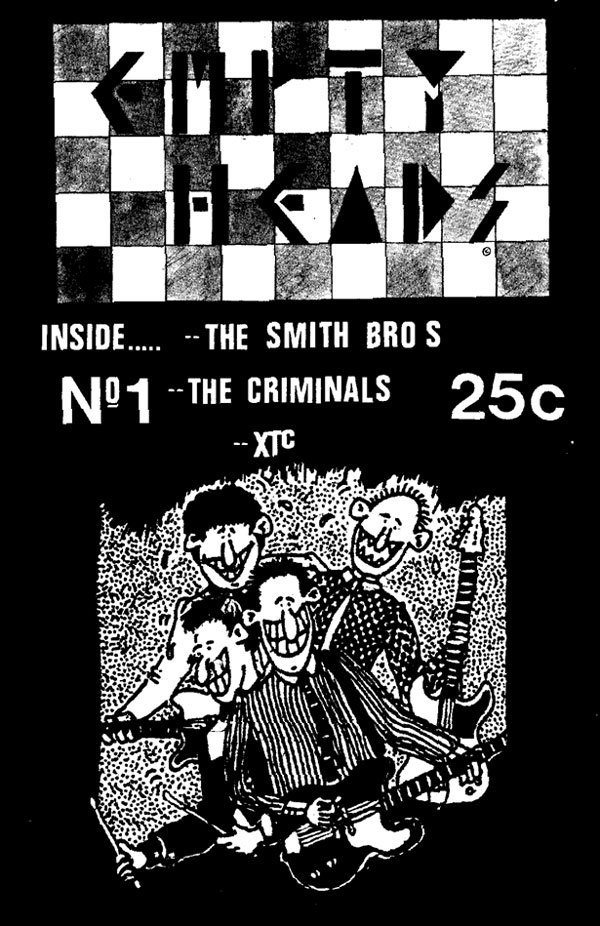
The first issue of Empty Heads, late 1980 - Paul Luker collection
The first issue sold for 25 cents in Auckland record shops and featured writing and photos by Luker, mainly about groups from South Auckland of a pub rock persuasion. Luker had been doing sound for South Auckland act The Criminals, who’d just finished a New Zealand tour.
Luker’s punk tastes predominated in the second issue with stories on Toy Love, The Spelling Mistakes and Shoes This High.

Empty Heads No. 2, early 1981 - Paul Luker collection
“The second issue was one thousand copies. It made no difference at the printer. Once that press started to go it was just paper. We folded it by hand, guillotined them and gave them away. Great wads in Record Warehouse. We got paid for a lot of them. Shopkeepers were brilliant. Simon Grigg was fantastic. I first went to him when he was at Taste Records in Parnell then he was in High Street, where I bought my first Wire record. He gave us an ad for Propeller Records. Record Exchange in K Road was good.”
“There weren’t piles of things on record counters in stores then. Rip It Up, even though we loved it, we were annoyed with it at that point because it still carried WEA reviews and there was too much of it. We just wanted to embrace it all at that point.”
Luker’s printing skills were soon co-opted by the busy Auckland post-punk scene. “It was really useful being in the printing industry. Someone always needed something done or had a question. I did film for Shoes This High (The Nose One EP) and The Gordons’ Future Shock EP singles and later artwork for The Newmatics (‘Square One’ from 1982) and Bongos (‘Falling’/ ‘Monotony’, 1982) singles.
“I did more Newmatics art work for a single that never happened. Footprints, dance steps and stuff. It must have been finished and given over because that’s how I got a job at Rip It Up. I was doing enough with Industrial Tapes to leave work and I’d get a couple of weeks work on deadline at Rip It Up out of Murray Cammick.”
Luker was ready to make his own music. “I had a belief that making and recording music was possible. My favourite bands were so independent – Shoes This High, The Gordons, Herco Pilots, Skeptics.” Sometime in 1981, Phantom Forth formed.
“With so many singles coming out at the time I thought recording would be just as easy, so I bought a 2-track from Oceania Sound. To figure out how to use it I started doing my own stuff fiddling around. I started recording with Mike Neilsen who later did sound for Miltown Stowaways (he would be half of Lava Lava in the 1990s). When I came back to Auckland after a nationwide poetry-reading tour with Pule, I flatted with him. He was a guitarist. I bought a Holden amp from a flatmate. He helped me choose a horrible acoustic Yamaha bass. The two of us – The Silver Ferns – we played a few parties. He was really into sound and went off to do that.
“I still wanted to do music. Lorraine Steele was around. She’d come back from Britain. She used to hang around with Herco Pilots, who became Coalition. I’d met Deb through Mark [Luker’s brother]. She used to hang around with Nick and Julian Hansen [The Spelling Mistakes]. Deb knew Lorraine. Before we knew it, we had a practice and that was Phantom Forth.
“It worked and I was gob smacked that it did. We just plugged and played to a DR55 drum machine. When we started, I was listening to Young Marble Giants. I was quite besotted with that for a while and Cabaret Voltaire, those sort of influences. We got a Roland 606 after that.
“It took us ages to get it together. Lorraine and Deb were good. I didn’t know a thing. We did two songs at The Lab studio way before The Last Rumba (live compilation album). Bill Latimer had said something to Chris Knox about us and we started to get known. Our first gig was an afternoon show at the Windsor Castle with three or four bands on. Deb was still playing with Freudian Slips, when we were practising Phantom Forth.”
The Auckland post-punk scene was peaking with plenty of venues including the Liberty Stage and XS Café.
The Auckland post-punk scene was peaking with plenty of venues including the Liberty Stage and XS Café operating in addition to the pubs, which put on original music. Paul Luker the fan was still stepping out.
“XS Café seemed to turn really ugly really quickly. Boot boys just seemed to destroy that. We didn’t like any confrontation and getting badges taken off you wasn’t fun. I got hung up over the lit fireplace there one evening. It was weird that place because it was so café. I remember seeing Johnny and the Hookers whack people with the mic stand. By the time the Reverb Room (nee Liberty Stage, on Symonds Street in the Edinburgh Castle) kicked in that was fine. Mind you, downstairs was rough. We’d got sick of it in town, although we went to Squeeze a few times.
“The scene was getting bigger. The Newmatics and The Screaming Meemees had huge followings that would cross over. It was good to be in that group of fans. There was security and fraternity.”
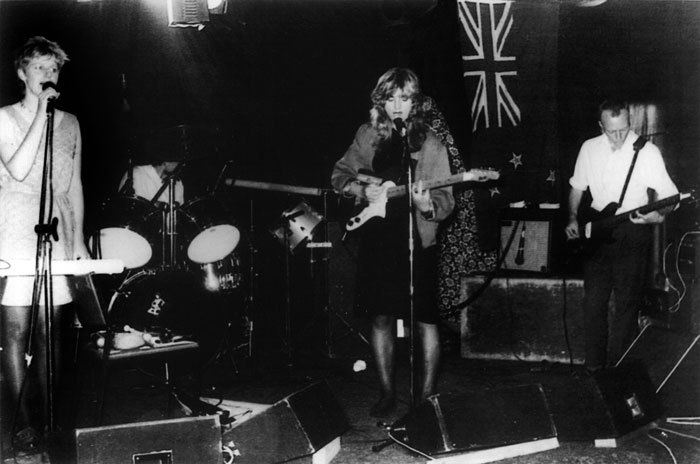
Phantom Forth at SPAM, 1983 - Paul Luker collection
It was 1983 before Phantom Forth became a regular presence on the now fractured and thinning city live scene. They played the final show at the Rumba Bar in Victoria Street on June 6, recording ‘Night Time Falls’ for the Flying Nun live compilation The Last Rumba. The scene survey featured, among others, Tall Dwarfs, The Exploding Budgies, Kevin Hawkins, Children’s Hour, This Sporting Life and The Stones from Dunedin.
“People had a fear of losing control. They were fearful of any aspect of it falling away. It was quite hard to get places to play and to get a record considered at three hundred pressings at the plant. You’d get shoved to the back of the line and when you got them back the vinyl was full of paper from someone else’s melted down pressing. So when the Rumba Bar stopped everyone held their breath. So we made events of those things. So much had happened there. Good bands and good times.”
Phantom Forth could be found the following month with fellow travellers Coalition BC, who’d risen from the remains of Herco Pilots and Kiwi Animal at the Kiwi Animal Dance at Knox Hall.
“The bands we’d been playing with – Flak and Eight Living Legs - were going overseas eventually. So I started looking around again and I liked everything that Brent Hayward did. Shoes This High was just fantastic. You never knew quite what was going to happen. It was unpredictable. Brent would push my button. Everything I did was way too straight for him and yet it never stopped him from involving us.”
Jewel Sanyo, the scene’s best observer, noted in Rip It Up in August that the group’s sound was “a truly danceable fist in the ear” before singling out the “silvery voiced” Lorraine Steele.
“That was getting to be our scene then. The idea of “the band” had gone for Brent and Julie (Kiwi Animal) and Coalition and performance had taken over. We’d moved on from just the exhilaration of the punk thrash. It became more of our life. The social politics became more intrinsic with it.
“We were quite happy to play some acoustic stuff and it wasn’t long after that the Old Synagogue was found. It sounded so good acoustically it added weight to the thought that it was good to make music that wasn’t so electrified.”
“Improvisation, that jazz thing, wasn’t part of it. If we had more electric gear we’d have used more. The Skeptics and Charlton Heston (a Skeptics offshoot) were doing the same sort of thing down in Palmerston North.”
Sanyo also noted new member Patrick Waller on cello and drums. Waller (now better known as DJ Dubhead) was playing in Silent Decree, a gothic act soon to release a cassette of studio material on their Sanctus Decay imprint.

Unrestful Movements, 55 Polish Workers, Phantom Forth and Flak at SPAM in Auckland's Symonds Street
On November 19, Phantom Forth was at new all age venue SPAM (Society for the Promotion of Alternatives in Music) in Symonds Street with women’s group Marie and the Atom, This Sporting Life and The Stridulators. Four days later, they were at Mainstreet Cabaret for a student radio benefit with 55 Polish Workers, Antibodies and Big Sideways.
It was clear there was still a lot of original music being created in the city, but with the exception of a few small run labels no outlet existed to release it. The ever-busy Paul Luker decided to start his own tape label – Industrial Tapes.
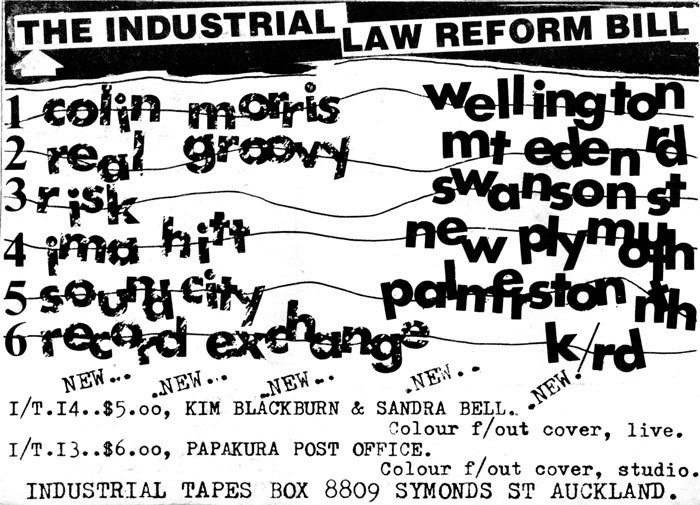
There had already been classic tapes released in New Zealand – House of Squirm’s Gorgonzola, Fetus Productions’ Self Manipulation on Last Laugh, Ima Hitt Records’ Palmerston North compilation Music To Do The Dishes To, Above Ground’s Gone Aiwa, Fishschool’s Present – Pastimes, and The Clean’s Odditties and more would follow over the next few years. Few surpassed Industrial Tapes for the quality of packaging, quantity of releases, reach of distribution and innovative sound. Luker’s printing skills and scene contacts were well used.
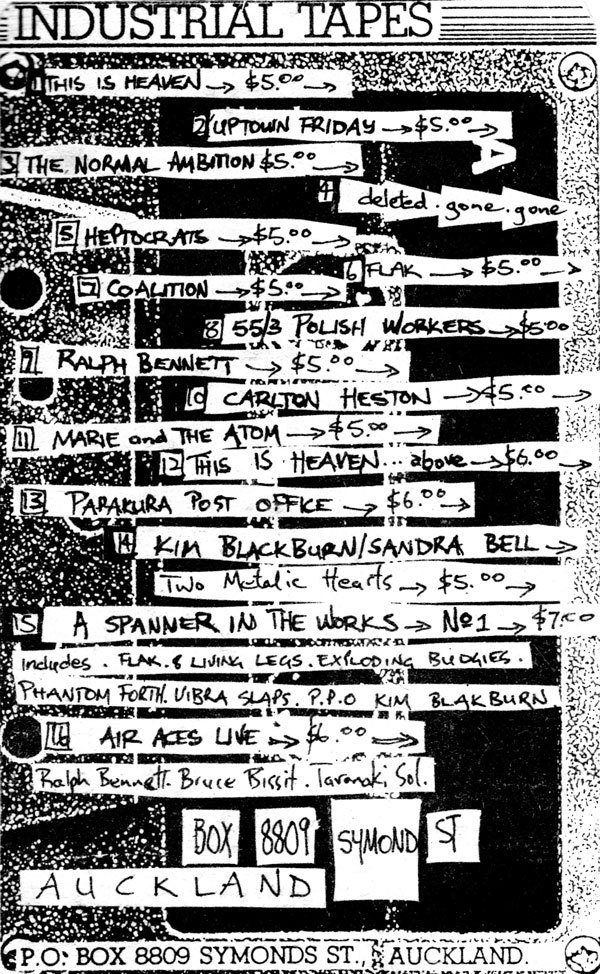
The first Industrial Tapes appeared in December 1983 to lukewarm reviews. First up was Uptown Friday, a live compilation of Kiwi Animal, Heptocrats and Papakura Post Office playing new venue the Old Synagogue in the city. Luker had met Brent Mason of Papakura Post Office at poetry reading. Uptown Friday would eventually sell over 300 copies.
Luker’s experimental project This Is Heaven and the Normal Ambition’s studio recorded Watch It There followed, also selling well.
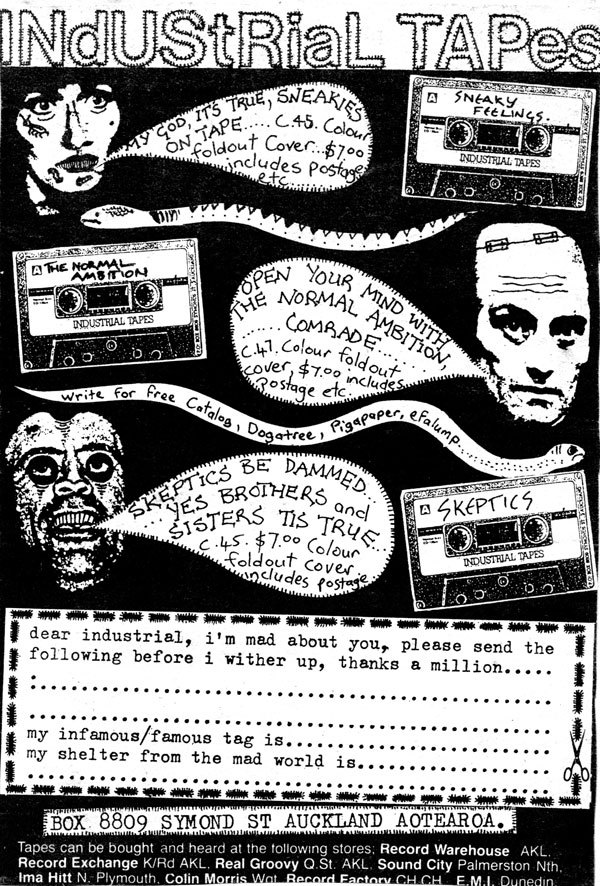
Industrial Tapes rapidly became a vibrant cottage industry for the industrious Luker: “You could buy the blank TDK tape from Direct Imports in Sandringham and you could buy the labels – excellent. I rushed Up Town Friday out even though This Is Heaven was all ready to go. At first I got Direct Imports to dub them. They fucked it up. They left 12 minutes of silence at the beginning so I spent the Christmas holidays hauling the tape out and cutting them for the first three to four hundred.
“The next run, I bought two Sony tape decks (expensive then) and a Nakamichi from the audio suite at the university and dubbed my own from then on. Within a year cassingles were huge and cassette decks were nothing.”
With the sound quality of some performances already low care had to taken. “We were already lo-fi enough not to want to degrade the sound further. We were conscious of that. We didn’t mind it being lo-fi. The attraction of doing things stripped down was pretty cool.”

The quality of the packaging, coloured glossy fold out booklets with cool tape labels was always high. It was a feature that stood Industrial Tapes out from the rest of the tape crowd.
“I loved reading the sleeves,” says Luker. “I always feel ripped off, still do today, when I don’t get something that says: ‘I do belong a bit more to this. I like your work. I want an interaction.’ ”
Industrial’s releases were announced with distinctive ads in Rip It Up, where Luker was working part-time.
By March 1984 the ad would announce nine releases already available by groups such as Flak, Coalition, Silent Decree, The Normal Ambition, Heptocrats, Ralph Bennett (a Taranaki bluesman) and 55 Polish Workers, featuring future Headless Chickens member Anthony Nevison and future S.P.U.D. and King Loser member Lance Strickland. Marie and the Atom, the Amazing Charlton Heston and the second This Is Heaven release were the other three releases.

Industrial Tapes live show at Auckland's Windsor Castle, 1984
Future tapes were mooted by Skeptics, Albatrocity and Children’s Hour (Luker taped live shows on their first national tour, although the results were never released). Vibraslaps, Stridulators, Hepers (not released), Papakura Post Office, Silent Decree and Squirm, together with two compilation albums rounded out the list. The new label was now one of the most prolific in New Zealand and the most adventurous.
“People would come to me like The Normal Ambition and later Ralph Bennett – people who even in my normally eclectic frame of mind I wouldn’t have touched, but they weren’t that bad,” says Luker. “I said, ‘I’ll make the tapes. How many do you want? I’ll try and sell as many as possible.’ They paid the $1.34 or whatever the tape cost and they got the label and the cover with it. They’d take them away to sell at gigs – whatever.
“By the time we got to Flak that tape sold eight to nine hundred and eventually over a thousand. The straight up momentum stayed up until that point. The Skeptics later sold well, as did Sneaky Feelings. Cassettes – people pretty soon got overwhelmed with them. They became so easy to do and duplicate that quite quickly the novelty faded. But in the beginning, we were lucky in that people had accepted tapes.”
By April, Industrial tapes were available in three Auckland outlets, Palmerston North, New Plymouth and Wellington, adding Christchurch and Dunedin, a month later.
In December, Phantom Forth played SPAM’s Christmas Death closing down show with Eight Living Legs, Infectious, Exploding Budgies, K4 and The Vibraslaps. Flying Nun Records wanted an EP from them, which was duly recorded and announced for release as early as March 1984, although continued delays with pressing held up the patchy but still sublime record, The Eepp, until December.
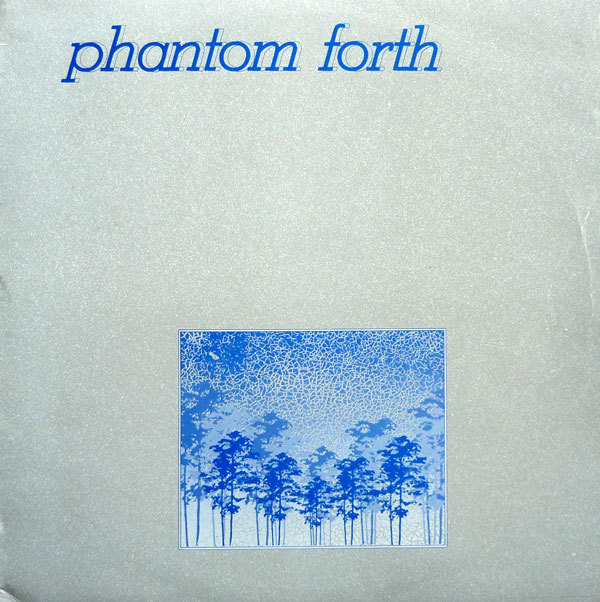
The 1984 Phantom Forth EP
“That was part of the first bunch of Auckland bands that Flying Nun dealt with in a group. A lot of us at the time were waiting to get pressings done. Because there was no business structure at Flying Nun – visibly the business structure didn’t exist to us – you had a chat in a pub. You might be at the same show as somebody or you might have a chat on the phone or go around to see Chris Knox. He came down to Progressive Studios at one point. It was so loose in that sense it totally reinforced that independence and you became really trusting. If there was a delay, there was a delay.”

Phantom Forth advertised with Flying Nun in 1984
Phantom Forth were playing out using a number of drummers including Robert from Eight Living Legs and Chris Williams from Coalition. They could be found on January 24 with 55 Polish Workers at the Globe and at the Windsor Castle on 19 February with Normal Ambition.
In April, an abbreviated Phantom Forth minus Debbie but including Hilary Ord from Albatrocity and Patrick Waller, headed south to play the Off The Deep End Improvisational Festival at Wellington’s Thistle Hall on a bill which included Kevin Hawkins and The Stridulators.
“We went and played in Palmerston North in Snailclamps on the way. We met Kiwi Animal there. They’d been touring around. Charlton Heston played as well. That was the Skeptics plus mates and they’d get industrial cutters and 44 gallon drums and just make horrendous noises. They used analog synths.
“I’d met the Skeptics years before when John Pule and I toured. There was a gallery in front of Snailclamps that we read in. I’d go down to Palmerston North and stay, then we’d go down to Wellington, where it was just so off the edge. I think some of the Wellington bands made it easier to get into experimental stuff up here. They were into mushrooms and cactus and that sort of thing.
“What a great mad, mad event that was. Those types of gigs were quite common for Wellington – that anarchic theatre. It was just as electrifying as seeing those punk bands for the first time.”
Phantom Forth ceased playing shortly after but Industrial Tapes rolled on. Releases from Kim Blackburn and Sandra Bell (Two Metallic Hearts), the Air Aces, Sneaky Feelings and the Skeptics (Said See Say) appeared with Spanner In The Works, a compilation featuring The Exploding Budgies and others.
Inevitably Luker tired of the work. “I got an amazing amount of stuff sent to me. Country singers from Papakura, you name it. There was a real lack of an outlet then for so many musicians, not just in our genre. It meant too much was riding on my shoulders. I talked to a few people to see if they wanted to take Industrial Tapes on. I tried to up the ante and met with Fetus Productions about one of their Japanese tape releases. They just wanted it distributed mainly.”
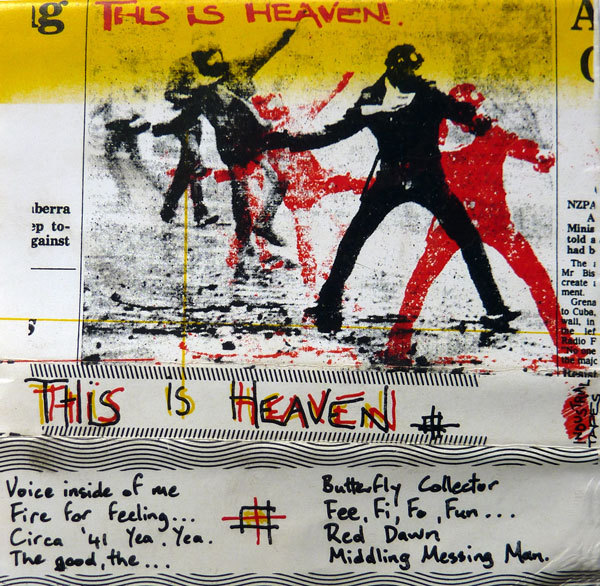
This Is Heaven's debut cassette (1983)
He decided to wind the tape label down and concentrate on This Is Heaven, his solo project. It’d been a wonderful rush of left field sound and enthusiasm with several significant achievements. For the first time since punk began women were playing, performing and recording their own music in all women groups. Industrial Tapes was the main conduit with Flying Nun Records under the influence of Chris Knox.
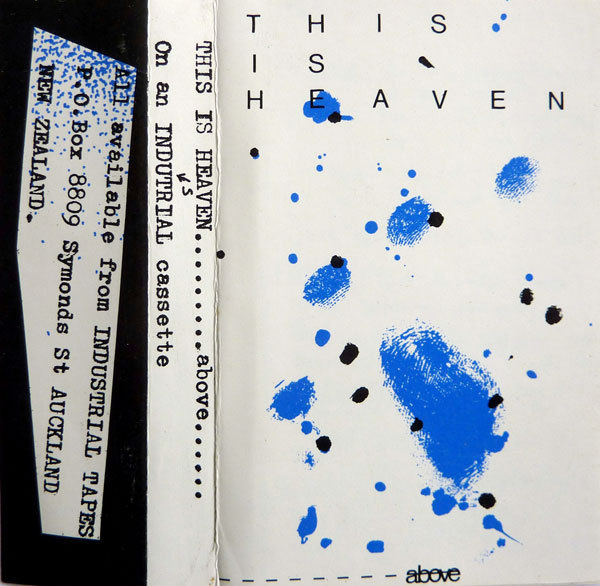
This Is Heaven's Above cassette (1984)
“We got to know Marie and The Atom and Vibraslaps,” says Luker. “The women I was flatting with, they ended up with Moa clothes in Grey Lynn and they had this independence then as well. There was a hippie strain going through there still. The whole house was feminist. By the time Industrial Tapes started, there was Julie Cooper and Kiwi Animal, Marie and the Atom and Vibraslaps. The guys who lived around that were the ones who educated ourselves or they got kicked out.”
The Phantom Forth’s Eepp (‘March’/ ‘Double Negative’/ ‘Caroline’/ ‘I Don’t Know You’/ ‘Liar’/ ‘Saw You Hide’/ ‘Dead Dream’), with five moody sound sketches of Auckland in the early to mid-1980s, finally appeared in November 1984.
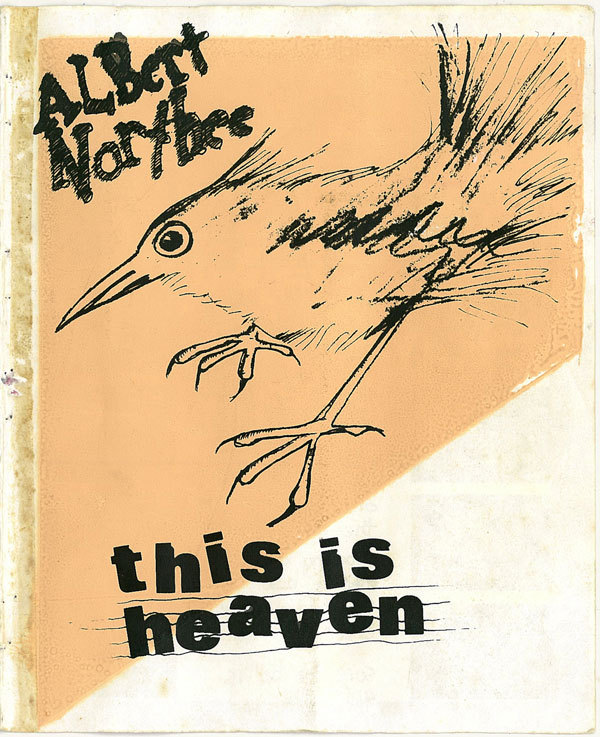
This Is Heaven's Albert Northee cassette (1984)
In February 1985, This Is Heaven’s Albert Northee book and tape appeared. Luker played shows as This Is Heaven at the Ponsonby Community Centre with the Mad Kiwi Ranter David Eggleton in July and the Windsor Castle in October with Vibraslaps. He saw out the year with one of his finest releases, This Is Heaven’s 200 Variations 7” single (‘Battered The Boy’/ ‘Mr Kingdom’/ ‘Turkish Otter Time’/ ‘Things Up The Shirtsleeves’).
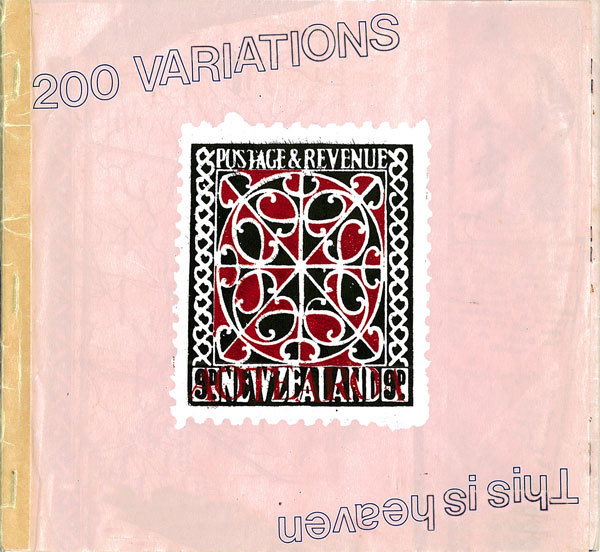
This Is Heaven's 200 Variations 7-inch EP (1985) was a joint release between Flying Nun and Industrial Tapes
--
